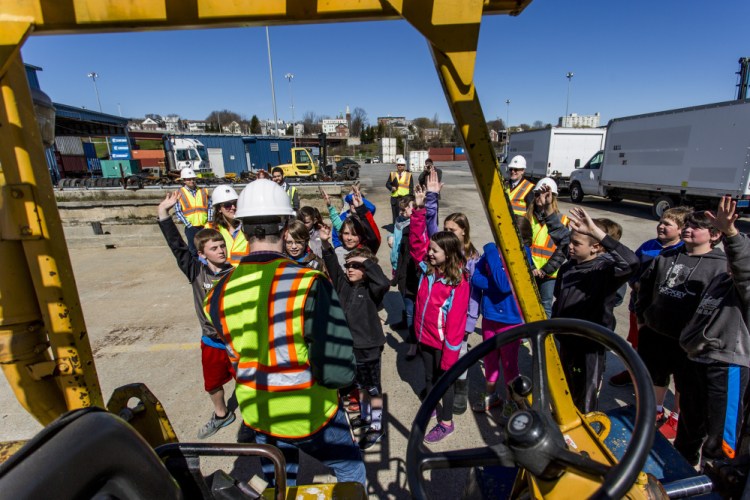From her neighborhood in South Portland, and every time she crosses the Casco Bay Bridge, 10-year-old Abbie Hews can see the massive crane that towers above the International Marine Terminal on Portland’s waterfront.
On Thursday, Abbie got to see the 200-foot-tall crane up close when she toured the Portland Harbor facility as part of a new educational program that highlights the broad reach of Maine’s shipping economy. The Dyer Elementary School student was among more than 200 fifth-graders who strolled around the 36-acre terminal that’s expected to handle 10,000 cargo containers this year.

David Arnold of the Maine Port Authority leads the students across the International Marine Terminal.
“I think it’s really cool,” Abbie said near the end of the tour. “I like the crane especially, because it’s really a lot bigger than I thought it was, and you see it all the time.”
The South Portland School Department and the Maine Port Authority worked together in recent months to develop an interdisciplinary curriculum for fifth-graders based on activities and resources at the International Marine Terminal. The curriculum will be available to other districts.
Since 2009, the state has invested $30 million to upgrade and expand the terminal and is negotiating a lease with Americold to build a $30 million cold-storage facility at the terminal sometime next year, said Jonathan Nass, deputy commissioner of the Maine Department of Transportation.
The curriculum emphasizes how Maine connects with the world through its ports, especially in transporting goods produced by farmers, fishermen and manufacturers across the state, said Patrick Arnold, president of Soli DG Inc., which operates the terminal for the state.
“It takes a village to do anything successful,” Arnold said. “The health of that village depends on the health of the economy.”
South Portland Superintendent Ken Kunin said an interdisciplinary curriculum strives to connect classroom learning with real-world experiences that many students will remember for decades.

Andrew Heffernan, Brady Mullen and Nolan Hobbs, all fifth-graders at Dyer Elementary School in South Portland, were part of a tour of the International Marine Terminal in Portland on Thursday morning to learn about shipping and the types of business the terminal does.
Sarah Maxwell, a fifth-grade teacher at Skillin Elementary School, developed the pilot curriculum after visiting the terminal in November. She tied lessons and activities to learning goals related to geography, math, reading, writing and vocabulary, she said.
After visiting the terminal on Thursday, students will analyze cargo packing lists to determine where goods originated and use measurements to calculate the volume of shipping containers, to name a few follow-up exercises.
“Getting kids out of the classroom and into the community makes the biggest, lasting impact,” Maxwell said. “There are just so many learning connections to be made here. They get to see how it’s all connected and think about how blueberries grown in Maine get to Iceland.”
Copy the Story Link
Send questions/comments to the editors.



Success. Please wait for the page to reload. If the page does not reload within 5 seconds, please refresh the page.
Enter your email and password to access comments.
Hi, to comment on stories you must . This profile is in addition to your subscription and website login.
Already have a commenting profile? .
Invalid username/password.
Please check your email to confirm and complete your registration.
Only subscribers are eligible to post comments. Please subscribe or login first for digital access. Here’s why.
Use the form below to reset your password. When you've submitted your account email, we will send an email with a reset code.